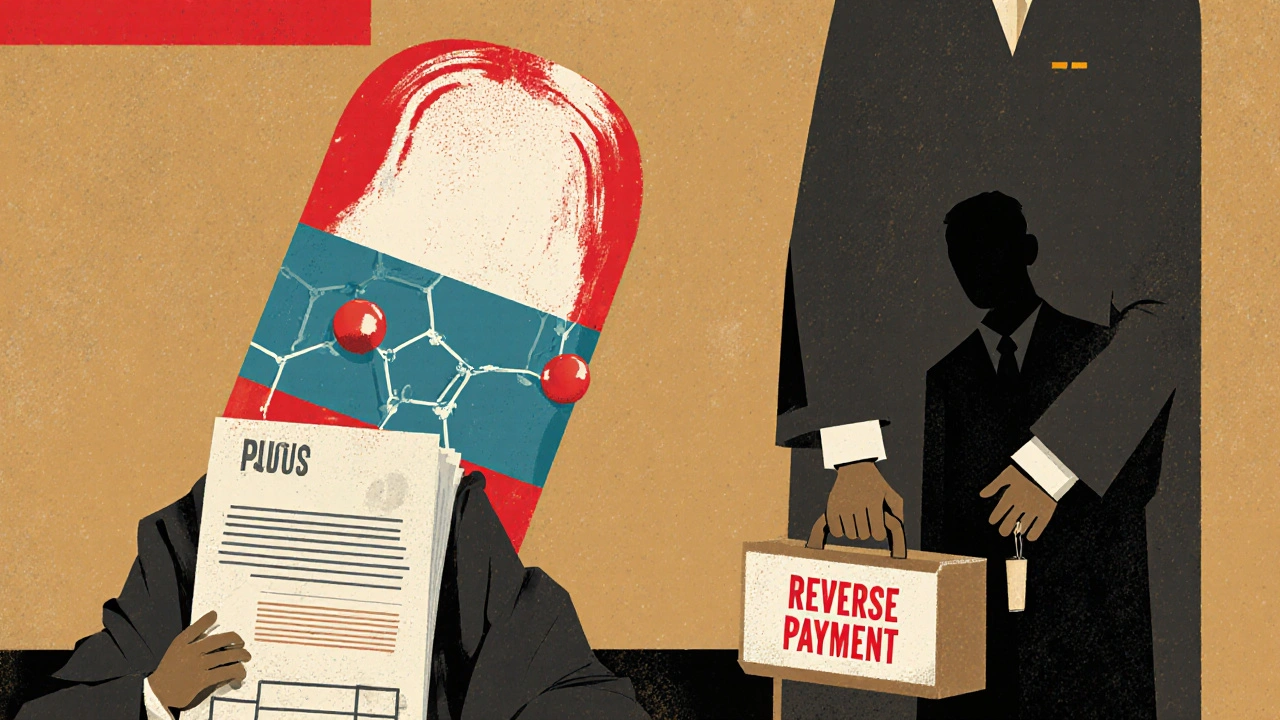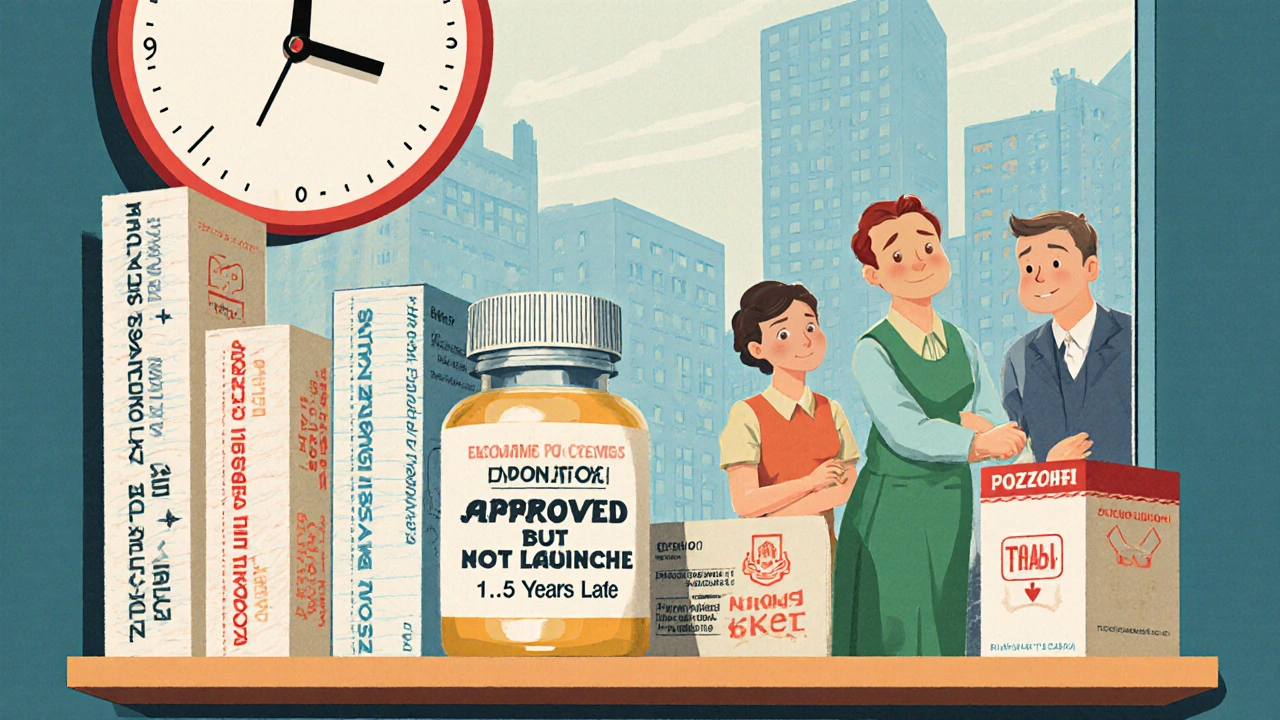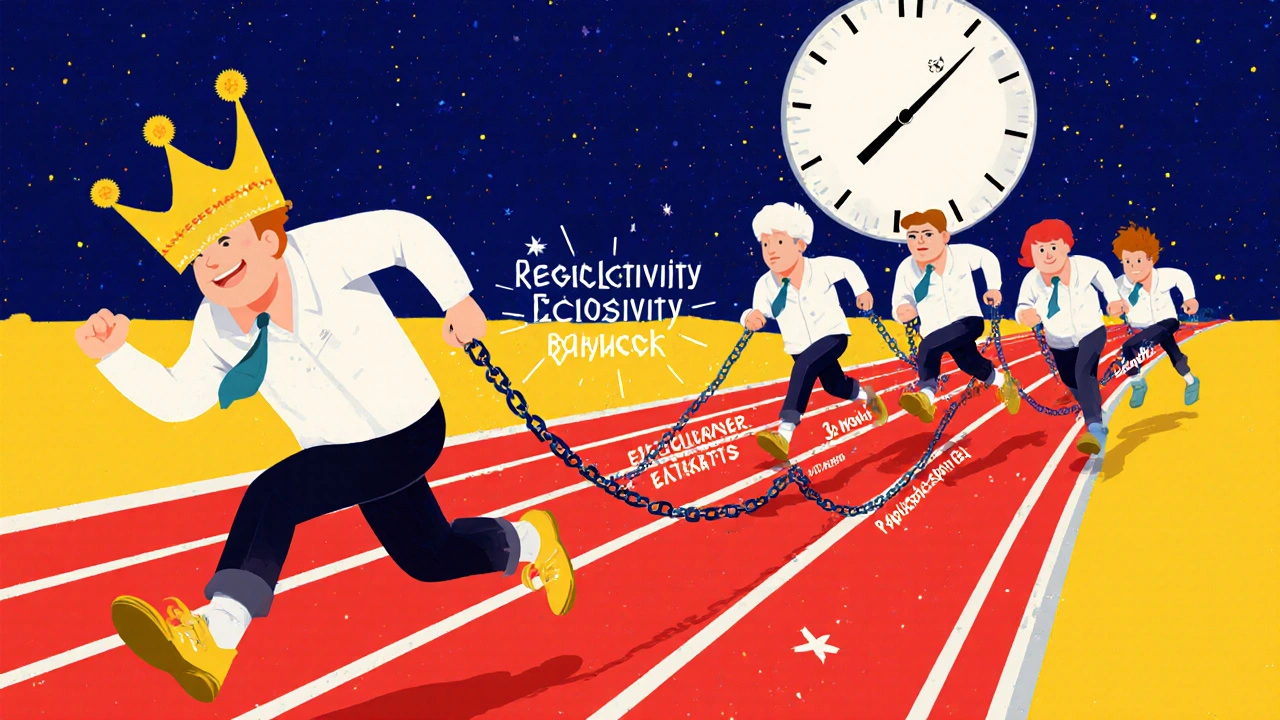Just because a brand-name drug’s patent expires doesn’t mean the generic version shows up on pharmacy shelves right away. In fact, it often takes years - sometimes more than two - for patients to actually get access to cheaper generic versions, even after the legal monopoly ends. This isn’t a glitch. It’s the system. And understanding how it works helps explain why some medications stay expensive long after they should be affordable.
Patent Expiration Isn’t the Finish Line
The common belief is simple: patent expires → generics launch. But that’s not how it works. A pharmaceutical patent lasts 20 years from the date it’s filed. But here’s the catch: drug development takes 8 to 10 years before the drug even hits the market. That means by the time a brand-name drug is sold to consumers, only 7 to 12 years of patent protection are left. Still, even when that clock runs out, generics don’t automatically appear. That’s because the U.S. has layers of legal protection beyond patents. The FDA grants regulatory exclusivity periods that block generics from entering, even if patents have expired. A new chemical entity gets 5 years of exclusivity. A drug with a new clinical use gets 3 years. Orphan drugs - those for rare diseases - get 7 years. And if a company runs extra pediatric studies, they get an extra 6 months tacked onto any existing exclusivity. These aren’t patents. They’re regulatory blocks. And they’re just as powerful.The ANDA Process: Approval ≠ Availability
Generic manufacturers don’t need to repeat the expensive clinical trials that brand-name companies did. Instead, they file an Abbreviated New Drug Application (ANDA) with the FDA. This application proves their version is bioequivalent - meaning it works the same way in the body. Sounds simple, right? But the process is anything but. The FDA’s average review time for an ANDA is about 25 months. That’s over two years just waiting for approval. And that’s if there are no legal hurdles. But here’s where things get complicated: generic companies often file a Paragraph IV certification when they believe a patent is invalid or not being infringed. That triggers a lawsuit from the brand-name company. And when that happens, the FDA can’t approve the generic for up to 30 months - even if the patent has technically expired. Worse, those lawsuits often drag on. Court cases can take 37 months or more to resolve. And even when the generic is approved, it doesn’t mean it hits the market. The FDA approved 1,165 generic drugs in 2021, but only 62% were available within six months of approval. Why? Because manufacturers still need to ramp up production, secure supply chains, and sometimes settle legal disputes that delay launch.Patent Thickets and Strategic Delays
Brand-name drug makers don’t rely on just one patent. They build “patent thickets” - a web of overlapping patents covering everything from the active ingredient to the pill’s coating, the manufacturing process, and even how it’s taken. A single drug can have 14 or more patents listed in the FDA’s Orange Book. Each one creates a new legal barrier. Drugs with more than 10 listed patents see delays that are 37% longer than those with fewer. Cardiovascular drugs, for example, face an average delay of 3.4 years after patent expiration before generics arrive. Dermatological drugs? Just 1.2 years. That’s not because one is harder to make - it’s because the brand-name companies have used more patents to lock the market. Some companies even use “product hopping” - making small, meaningless changes to the drug (like switching from a pill to a liquid) and then patenting the new version. This tricks patients and doctors into switching, keeping them off cheaper generics. The CREATES Act of 2019 was designed to stop this by forcing brand-name companies to provide samples to generic makers. But enforcement is still inconsistent.The 180-Day Exclusivity Trap
There’s one big incentive for generic companies: the first one to challenge a patent gets 180 days of exclusive market access. That’s a huge financial reward - no other generics can enter during that time. But it’s also a trap. To claim that exclusivity, the first filer must launch within 75 days of FDA approval. If they’re late - because of manufacturing problems, quality control issues, or legal disputes - they lose it. In 2022, 22% of first filers forfeited their exclusivity because they couldn’t get their product ready on time. Another 10% lost it due to court rulings. This pressure leads to rushed production. Some companies cut corners, leading to recalls. Others sit on their approval, waiting for the right moment to launch - sometimes even after the 180 days have passed - to maximize profit. The result? The market stays monopolized longer than it should.
Reverse Payments and Secret Deals
Perhaps the most controversial tactic is the “reverse payment” settlement. That’s when the brand-name company pays the generic maker to delay launching. It sounds backwards - why would a company pay someone to not compete? But it’s profitable for both sides. The brand-name company keeps high prices. The generic company gets a payout without the risk of a lawsuit. The FTC found that these deals delay generic entry by an average of 2.1 years. And they’re expensive: consumers lose $3.5 billion every year because of them. The Supreme Court ruled in 2013 that these deals could violate antitrust laws, and in 2021, the Amarin v. Helsinn case reinforced that secret settlements are illegal. But they still happen - just more quietly.Why Some Generics Take Longer Than Others
Not all drugs are created equal when it comes to generic entry. Small molecule drugs - the traditional pills and capsules - usually see generics within 1.5 years of patent expiration. But complex drugs? That’s a different story. Biologics - drugs made from living cells, like insulin or rheumatoid arthritis treatments - face a whole other system. The BPCIA, passed in 2010, created a separate approval pathway for biosimilars (the generic version of biologics). But it’s slow. On average, it takes 4.7 years after patent expiration for a biosimilar to launch. Why? Because these drugs are incredibly complex to replicate. Even tiny differences in manufacturing can change how they work. And then there’s the market itself. The generic drug industry is dominated by just a few players: Teva, Viatris, and Sandoz control nearly half the U.S. market. When one of them delays a launch, it affects the whole system. Smaller companies often lack the resources to fight patent battles or build multiple backup manufacturing lines. So they sit on the sidelines.What’s Changing - and What’s Not
There have been efforts to fix this. The FDA’s GDUFA II program, updated in 2023, aimed to cut review times for complex generics from 36 months to 24. But only 62% of applications met that target in 2024. The Orange Book Transparency Act, which went live in January 2023, forced companies to list patents more accurately. That cut patent disputes by 32% in the first year. The FDA is also testing AI to speed up bioequivalence testing. Early results show it could cut development time by 25%. That’s promising. But it won’t fix the legal games. Meanwhile, brand-name companies are still using “patent evergreening” - filing new patents on minor changes like dosage forms or delivery systems. A 2024 study found that 68% of brand-name drugs get at least one new patent within 18 months of the original expiring. That keeps generics locked out, even when the core patent is gone.
The Real Cost of Delay
The financial impact is massive. Generic drugs make up 92% of all prescriptions filled in the U.S. But they account for only 16% of total drug spending. That’s because they’re cheap - often 80-90% less than brand-name versions. When generics are delayed, patients pay more. Medicare alone loses $1.2 billion every year for every top-selling drug that doesn’t go generic on time. In 2023, the U.S. healthcare system saved $373 billion because of generics. But if those savings were even bigger - if generics launched faster - the savings could be hundreds of billions more. For patients with chronic conditions like diabetes, high blood pressure, or depression, waiting months or years for a cheaper option isn’t just inconvenient. It’s dangerous.What Patients Can Do
You can’t control the patent system. But you can take action:- Ask your pharmacist if a generic is available - even if your doctor didn’t prescribe one.
- Check the FDA’s website for approved generics. If it’s approved but not on shelves, ask why.
- If your medication is expensive and you suspect a delay, talk to your doctor about alternatives. Sometimes another drug in the same class has a cheaper generic.
- Use price comparison tools like GoodRx. They often show the lowest price, even if it’s from a different pharmacy.
Bottom Line
The system was designed to balance innovation and access. But over time, it’s become a tool for delay. Patent expiration is just the starting line. The real race - for affordable medicine - is still long and full of obstacles. Until the legal and regulatory barriers are addressed, millions of Americans will keep paying more than they should for drugs that could, and should, be cheap.Why don’t generic drugs appear immediately after a patent expires?
Even after a patent expires, generic drugs can’t launch right away because of regulatory exclusivity periods, pending lawsuits, manufacturing delays, and strategic legal tactics like the 30-month stay provision. The FDA must approve the generic first, and manufacturers must be ready to produce it at scale - which can take months or years.
What is the Hatch-Waxman Act and how does it affect generics?
The Hatch-Waxman Act of 1984 created the modern system for generic drug approval. It allows generic manufacturers to use the Abbreviated New Drug Application (ANDA) process to prove bioequivalence without repeating clinical trials. It also established the 180-day exclusivity period for the first generic to challenge a patent and the 30-month stay that delays approval if a lawsuit is filed. It was meant to balance innovation with competition - but it’s now used to delay generics.
What’s the difference between a patent and regulatory exclusivity?
A patent is a legal right granted by the U.S. Patent Office that protects the invention for 20 years. Regulatory exclusivity is granted by the FDA and blocks other companies from selling a generic, even if the patent has expired. Examples include 5 years for a new chemical entity or 7 years for an orphan drug. These are separate protections - and both can delay generic entry.
Why do some generic drugs take longer to launch than others?
Complex drugs like biologics, injectables, or inhalers are harder to replicate and require longer approval times. Drugs with multiple patents (patent thickets) face more lawsuits and delays. High-revenue drugs attract more legal challenges, which can slow things down. Meanwhile, simpler pills with one patent often see generics within a year or two.
Can I speed up access to a generic drug?
You can’t force a launch, but you can ask your doctor or pharmacist if a generic is approved and available. If it’s approved but not on the shelf, ask why. Use tools like GoodRx to compare prices. Sometimes switching to a different drug in the same class with an existing generic can save you money immediately.


jalyssa chea
November 18, 2025 AT 11:43so like i just paid 400 for my blood pressure med and found out the generic was approved 8 months ago but still not on shelves wtf is this system even for
Gary Lam
November 18, 2025 AT 18:29lol the pharma bros really out here playing chess while we’re stuck buying single pills at CVS like it’s a blackjack table
Noel Molina Mattinez
November 20, 2025 AT 11:04patent thickets are just corporate greed dressed up as legal strategy
Roberta Colombin
November 20, 2025 AT 22:20It is important to remember that access to affordable medication is a basic health need. Many families choose between medicine and groceries. We must push for reform that prioritizes people over profits.
Dave Feland
November 22, 2025 AT 10:42It is an indisputable fact that the Hatch-Waxman Act, while ostensibly designed to foster competition, has been systematically weaponized by entrenched pharmaceutical interests to perpetuate monopolistic pricing structures through strategic litigation and regulatory arbitrage. The 30-month stay provision is not a procedural safeguard-it is a legal loophole enabling price gouging.
Ashley Unknown
November 23, 2025 AT 14:58Have you ever stopped to think that this isn’t just about money? It’s about control. Big Pharma doesn’t just want to delay generics-they want to make sure you’re dependent on their brand, that you’re terrified to switch, that you’ll beg your doctor to keep prescribing the expensive version even when it’s clear the generic would work just fine. And then they pay off lawmakers, silence whistleblowers, and bury studies that prove their drugs aren’t even better. It’s not capitalism-it’s a cartel. And we’re all the hostages.
Georgia Green
November 23, 2025 AT 22:15i checked goodrx for my diabetes med and the generic was 12 bucks at walgreens but my insurance said it wasn't available. called the pharmacy and they said the FDA approved it last year but they haven't ordered it yet. wtf
Christina Abellar
November 24, 2025 AT 11:12Patients shouldn’t have to fight this hard for affordable medicine. Simple solutions exist-why aren’t they being used?
Eva Vega
November 25, 2025 AT 19:26The regulatory exclusivity frameworks under the FDCA, particularly 5-year NCE exclusivity and 3-year new use exclusivity, function as de facto market barriers that supersede patent expiration timelines. This creates a bifurcated competitive landscape where bioequivalence is irrelevant to market access.
Matt Wells
November 26, 2025 AT 09:26One must acknowledge that the pharmaceutical industry’s investment in R&D necessitates a return on capital. While the delays are lamentable, the system incentivizes innovation. Without these protections, we would see fewer breakthrough therapies.
Margo Utomo
November 28, 2025 AT 03:43So we’re telling people with diabetes they have to wait 2 years for a $12 pill because some CEO got a bonus? 🤡💸
George Gaitara
November 29, 2025 AT 04:06This whole system is rigged. I’ve seen it firsthand-my mom’s asthma inhaler was approved in 2021. Still not available. Meanwhile, the brand-name version went up 17% last year. And they call this healthcare? More like healthcare extortion.